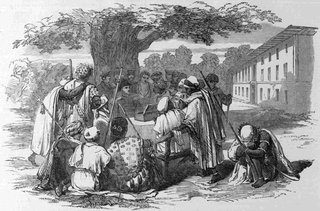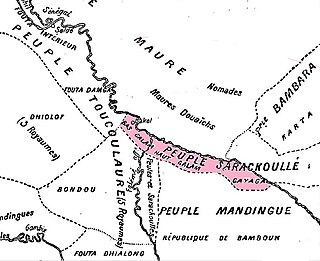
Banjul, officially the City of Banjul, is the capital of The Gambia. It is the centre of the eponymous administrative division which is home to an estimated 400,000 residents, making it The Gambia's largest and most densely populated metropolitan area. Banjul is located on St Mary's Island, where the Gambia River enters the Atlantic Ocean.

Samuel Hodge, VC was a West Indian soldier in the British Army and a recipient of the Victoria Cross, the highest award for gallantry in the face of the enemy that can be awarded to British and Commonwealth soldiers. From the island of Tortola in the British Virgin Islands, he was the second black man to be awarded the Victoria Cross after William Hall.

Ségou is a town and an urban commune in south-central Mali that lies 235 kilometres (146 mi) northeast of Bamako on the right bank of the River Niger. The town is the capital of the Ségou Cercle and the Ségou Region. With 130,690 inhabitants in 2009, it is the fifth-largest town in Mali.

Serekunda or Serrekunda is the largest urban centre in The Gambia. It is situated close to the Atlantic coast, on the Gambia River, near the capital, Banjul. Serekunda and Banjul form an urban area known as the Kombos, with about half of the population of the Gambia.

Jufureh is a town in the Gambia, 30 kilometres inland on the north bank of the River Gambia in the North Bank Division near Kunta Kinteh Island. The town is home to a museum and Fort Jillifree.

The Soninke people are a West African Mande-speaking ethnic group found in Mali, southern Mauritania, eastern Senegal, The Gambia, and Guinea. They speak the Soninke language, also called the Serakhulle or Azer language, which is one of the Mande languages. Soninke people were the founders of the ancient empire of Ghana or Wagadou c. 200–1240 CE, Subgroups of Soninke include the Jakhanke, Maraka and Wangara. When the Ghana empire was destroyed, the resulting diaspora brought Soninkes to Mali, Mauritania, Senegal, Gambia, Burkina Faso, Côte d'Ivoire, Guinée-Conakry, modern-day Republic of Ghana, Kano in Nigeria, and Guinea-Bissau where some of this trading diaspora was called Wangara, leading to the saying “when Americans landed on the moon, a Soninke was already there” in Senegal, with other versions across West Africa.

Hadji Oumarûl Foutiyou Tall, born in Futa Tooro, present-day Senegal, was a Senegalese Tijani sufi Toucouleur Islamic scholar and military commander who founded the short-lived Toucouleur Empire, which encompassed much of what is now Senegal, Mauritania, Guinea and Mali.

The Jola or Diola are an ethnic group found in Senegal, the Gambia, and Guinea-Bissau. Most Jola live in small villages scattered throughout Senegal, especially in the Lower Casamance region. The main dialect of the Jola language, Fogni, is one of the six national languages of Senegal.
The Niominka people are an ethnic group in Senegal living on the islands of the Saloum River delta. They are currently classified as a subgroup of the Serer.

Gunjur is a small coastal town in south-western Gambia. It is located in Kombo South District in the Western Division. As of 2009, it has an estimated population of 17,520.
The Jakhanke -- also spelled Jahanka, Jahanke, Jahanque, Jahonque, Diakkanke, Diakhanga, Diakhango, Dyakanke, Diakhanké, Diakanké, or Diakhankesare -- are a Manding-speaking ethnic group in the Senegambia region, often classified as a subgroup of the larger Soninke. The Jakhanke have historically constituted a specialized caste of professional Muslim clerics (ulema) and educators. They are centered on one larger group in Guinea, with smaller populations in the eastern region of The Gambia, Senegal, and in Mali near the Guinean border. Although generally considered a branch of the Soninke, their language is closer to Western Manding languages such as Mandinka.

Kombo was a kingdom and later a chieftaincy in Gambia during the colonial period. Kombo was part of the Mali Empire and gained independence after its fall, and was then ruled by the Sambou Bainunka clan. Mansa Karapha Yalli Jatta became the first King of Kombo, after seeking help from the then independent Kaabu Empire to establish the Kingdom of Kombo, he married the daughter of the Bainuk Queen Wullending Jasseh of Sanyang who sits at Gunjur and took her to Busumbala. Mansa Karapha Yalli Jatta was from the Jatta (Lion) clan who claim ancestry from Sundiata Keita the first Emperor of the Mali Empire. Kombo was ruled by two families, the Jatta (Djatta) and Bojang (Bodian) clans, when one clan becomes Mansa, the other clan gets to choose the crown prince from their own clan and vice versa. From 1840-1855 Mansa Suling Jatta was the King of Kombo, he was killed in the Soninke-Marabout war, and most of the Jatta clan moved to other regions.
The Battle of Kansala or Turban Keloo was the siege of the capital of the Kaabu federation by the Imamate of Futa Jallon, allied with rebellious Fula people from Kaabu itself. The battle, which saw the town completely destroyed, ended Mandinka hegemony over Africa’s Atlantic coast begun by the Mali Empire.

George Abbas Kooli D'Arcy was a British soldier and colonial administrator. He was governor of the Gambia from 1859 to 1866, and governor of the Falkland Islands from 1870 to 1876.
Aja Nyimasata Sanneh-Bojang was a Gambian politician. She was the first woman to be elected to the Gambian National Assembly, when she won the seat of Northern Kombo for the People's Progressive Party. Although she kept the seat in 1987, she was deselected by her party and did not contest the 1992 election.
Suling Jatta was a Mandinka King of Kombo during the mid-nineteenth century.

Luke Smythe O'Connor was an Irish military officer and colonial administrator. He served as Governor of the Gambia from 1852 to 1859, and held senior roles in the Colony of Jamaica during the 1860s, including President of the Privy Council of Jamaica.

The Soninke-Marabout War of 1850 to 1856 was a civil war between factions of the Kingdom of Kombo in the Gambia. The war resulted from a dispute between the Soninke people – pagans who were the ruling class in Kombo – and the Marabouts – a radical Muslim group with no representation in the governance of Kombo, partially inspired by Jihad. The British Empire, to whom parts of Kombo had been ceded by the Soninke since 1816, was initially reluctant to intervene. However, during the course of the war, the British intervened on two occasions. British forces stormed the Marabout town of Sabbajee twice, in 1853, and again in 1855, razing the town following the second intervention.
Daniel Robertson was a British colonial administrator who served as Colonial Secretary of the Gambia from 1849 to circa 1865. He was Acting Governor of the Gambia from April 1859 to September 1859, and in 1851.

Gajaaga, also known as Galam, was a Soninke kingdom in on the upper Senegal river that existed from before 1000CE to 1858. The kingdom was mainly located in present day Senegal and some parts of Mali. It was sometimes referred to as the Land of Gold, which it exported in large quantities, and 'Galam' in fact means 'gold' in Wolof. In the middle of the 17th century, Gajaaga was perhaps the most powerful state in the upper Senegal river region. It controlled both banks of the river from the area of Kayes downstream to Bakel.












